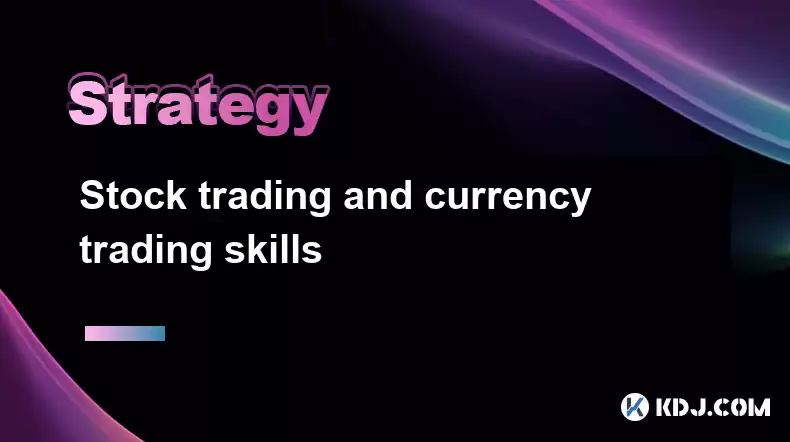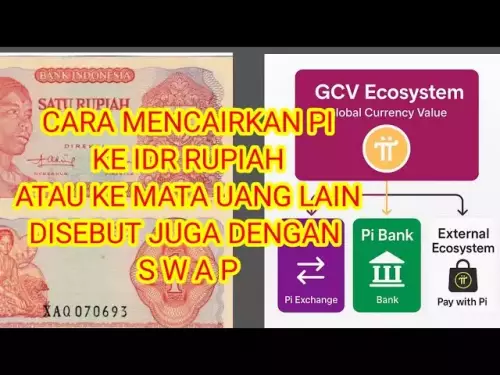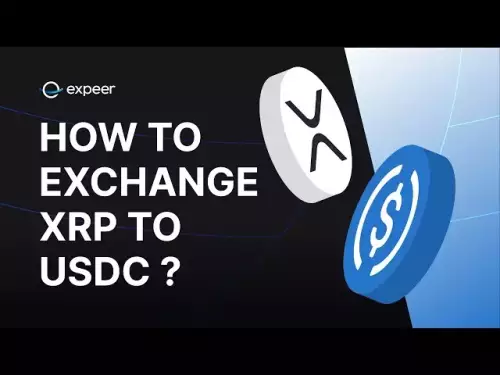-
 bitcoin
bitcoin $112715.707551 USD
-1.71% -
 ethereum
ethereum $4101.475385 USD
-3.01% -
 tether
tether $1.000644 USD
-0.02% -
 bnb
bnb $1207.619465 USD
-6.77% -
 xrp
xrp $2.501451 USD
-3.98% -
 solana
solana $202.947124 USD
-3.32% -
 usd-coin
usd-coin $1.000295 USD
0.04% -
 dogecoin
dogecoin $0.203884 USD
-4.47% -
 tron
tron $0.317154 USD
-1.72% -
 cardano
cardano $0.695009 USD
-4.43% -
 hyperliquid
hyperliquid $38.853961 USD
-8.23% -
 chainlink
chainlink $18.988674 USD
-4.64% -
 ethena-usde
ethena-usde $1.000233 USD
-0.03% -
 stellar
stellar $0.337050 USD
-3.63% -
 bitcoin-cash
bitcoin-cash $536.861728 USD
-1.28%
Stock trading and currency trading skills
Understanding the key concepts of stock trading, including market capitalization, dividends, and investing strategies, is essential for successful participation in the stock market.
Jan 09, 2025 at 04:56 am

- Understanding the similarities and differences between stock trading and currency trading
- The fundamentals of stock trading, including market capitalization, dividends, and investing strategies
- The key components of currency trading, such as currency pairs, exchange rates, and spreads
- Practical skills for successful stock and currency trading, including technical analysis, market analysis, and risk management
- Advanced strategies for experienced traders, such as options trading and futures trading
- Market Capitalization: Refers to the value of a company's outstanding shares and is a measure of its size and market presence. Larger companies typically have higher market caps and are considered less risky investments.
- Dividends: Distributions paid to shareholders from a company's profits or retained earnings. Dividends provide a source of passive income for investors and indicate the company's financial health.
- Investing Strategies: Include value investing (buying undervalued stocks), growth investing (investing in rapidly growing companies), and income investing (focusing on stocks with high dividend yields).
- Currency Pairs: Trading occurs in currency pairs, such as EUR/USD (Euro/US Dollar) or GBP/JPY (British Pound/Japanese Yen). Traders try to predict currency price movements relative to each other.
- Exchange Rates: The value of one currency relative to another, constantly fluctuating in the foreign exchange market. Currency traders speculate on these exchange rate movements to make profits.
- Spreads: The difference between the bid (selling) price and the ask (buying) price of a currency pair. Spreads represent the commission charged by brokers for facilitating trades.
- Technical Analysis: Involves analyzing past price data to identify trends, patterns, and support and resistance levels. Traders use indicators and charting tools to make trading decisions.
- Market Analysis: Monitoring macroeconomic data, news events, and market sentiment to assess the direction of the market. Traders consider factors like interest rates, economic growth, and geopolitical events.
- Risk Management: Managing exposure to potential losses is crucial. Traders set stop-loss orders to limit downside risk and calculate risk-reward ratios to ensure profitability.
- Options Trading: Provides the option but not the obligation to buy (call option) or sell (put option) an asset at a specified price and expiration date. Traders can use options to hedge against risk or speculate on market movements.
- Futures Trading: Contracts that obligate buyers to purchase or sellers to deliver an asset at a predetermined price on a future date. Futures are used for hedging, speculating on price movements, and locking in prices.
- What are the risks involved in stock and currency trading?
- Both stock and currency trading involve significant risks of capital loss. Market volatility, economic conditions, and geopolitical events can adversely impact investment performance.
- How much capital do I need to start trading?
- The amount of capital required varies depending on the type of trading and the risk tolerance of the trader. It's recommended to start with a small amount and gradually increase it as experience is gained.
- How do I choose a reputable broker?
- Look for brokers licensed by respected regulatory agencies, offer competitive spreads and commissions, and provide reliable customer support. Consider researching online reviews and broker comparisons.
- Can I make a living from trading?
- While it's possible to make a living from trading, it requires significant knowledge, experience, and a strong understanding of market dynamics. Consistent profitability requires dedication, discipline, and risk management skills.
- Should I trade on margin?
- Margin trading involves borrowing funds from a broker to increase potential gains. However, it also amplifies potential losses. Margin trading is recommended only for experienced traders with a high risk tolerance and a solid understanding of financial instruments.
Disclaimer:info@kdj.com
The information provided is not trading advice. kdj.com does not assume any responsibility for any investments made based on the information provided in this article. Cryptocurrencies are highly volatile and it is highly recommended that you invest with caution after thorough research!
If you believe that the content used on this website infringes your copyright, please contact us immediately (info@kdj.com) and we will delete it promptly.
- Coinbase vs. Binance: Navigating the BNB Listing Landscape
- 2025-10-16 06:40:01
- Canadian Coin Alert: Is That Gold Penny Worth a Fortune?
- 2025-10-16 06:40:01
- PayPal, PYUSD, and Stablecoins: Riding the Wave of Digital Finance
- 2025-10-16 04:50:01
- Milk Mocha's $HUGS Token: Why the Whitelist & Presale 2025 are Exploding
- 2025-10-16 04:30:01
- DeepSnitch AI: The Next Big Thing on BNB Chain and Binance Listings?
- 2025-10-16 05:43:02
- Microsoft, Bitcoin, and GitHub: A Balancing Act in the Digital Age
- 2025-10-16 04:30:01
Related knowledge

Practical parameter settings for a Bitcoin multi-timeframe moving average system
Sep 18,2025 at 10:54pm
Optimizing Timeframe Combinations for Bitcoin Trading1. Selecting appropriate timeframes is crucial when building a multi-timeframe moving average sys...

How can I filter out false breakouts in Dogecoin high-frequency trading?
Sep 22,2025 at 01:00am
Understanding False Breakouts in Dogecoin Trading1. A false breakout occurs when Dogecoin's price appears to move beyond a defined support or resistan...

Techniques for identifying tops and bottoms in the Bitcoin on-chain NVT model
Sep 20,2025 at 07:54pm
Understanding the NVT Model in Bitcoin Analysis1. The Network Value to Transactions (NVT) ratio is often described as the 'P/E ratio' of the cryptocur...

What does the surge in open interest in Bitcoincoin futures mean?
Sep 20,2025 at 11:18pm
Understanding the Surge in Dogecoin Futures Open Interest1. A surge in open interest within Dogecoin futures indicates a growing number of active cont...

How can I use the Ethereum USDT premium to gauge market sentiment?
Sep 18,2025 at 11:55pm
Understanding the Ethereum USDT Premium1. The Ethereum USDT premium refers to the price difference between USDT (Tether) traded on Ethereum-based plat...

What should I do if Ethereum staking yields decline?
Sep 20,2025 at 06:18am
Understanding the Causes Behind Declining Ethereum Staking Yields1. The Ethereum network transitioned to a proof-of-stake consensus mechanism with the...

Practical parameter settings for a Bitcoin multi-timeframe moving average system
Sep 18,2025 at 10:54pm
Optimizing Timeframe Combinations for Bitcoin Trading1. Selecting appropriate timeframes is crucial when building a multi-timeframe moving average sys...

How can I filter out false breakouts in Dogecoin high-frequency trading?
Sep 22,2025 at 01:00am
Understanding False Breakouts in Dogecoin Trading1. A false breakout occurs when Dogecoin's price appears to move beyond a defined support or resistan...

Techniques for identifying tops and bottoms in the Bitcoin on-chain NVT model
Sep 20,2025 at 07:54pm
Understanding the NVT Model in Bitcoin Analysis1. The Network Value to Transactions (NVT) ratio is often described as the 'P/E ratio' of the cryptocur...

What does the surge in open interest in Bitcoincoin futures mean?
Sep 20,2025 at 11:18pm
Understanding the Surge in Dogecoin Futures Open Interest1. A surge in open interest within Dogecoin futures indicates a growing number of active cont...

How can I use the Ethereum USDT premium to gauge market sentiment?
Sep 18,2025 at 11:55pm
Understanding the Ethereum USDT Premium1. The Ethereum USDT premium refers to the price difference between USDT (Tether) traded on Ethereum-based plat...

What should I do if Ethereum staking yields decline?
Sep 20,2025 at 06:18am
Understanding the Causes Behind Declining Ethereum Staking Yields1. The Ethereum network transitioned to a proof-of-stake consensus mechanism with the...
See all articles










































































